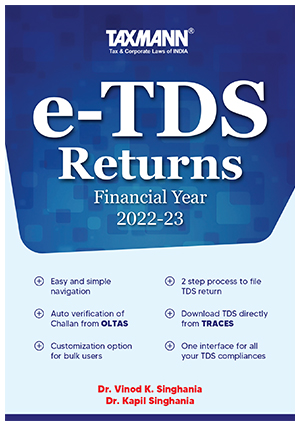TDS Under Section 194C | TDS on Payment to Contractor
- Blog|Income Tax|
- 4 Min Read
- By Taxmann
- |
- Last Updated on 2 August, 2022
1. Section 194C
Sec 194C provides for deduction of tax from payment of works contract made to contractor or sub-contractor. Any person carrying out any work in pursuance of a contract between a specified person and the resident contractor is required to deduct tax at source.
Check out Taxmann's TDS Ready Reckoner which provides a detailed analysis of TDS & TCS provisions and guidance on controversial topics with supporting case laws. It covers section-wise TDS chapters, queries on TDS, Charts,FAQs on Section(s) 194P/194Q & 206C(1H)&Deferment of TDS on ESOPs by Start-ups.
2. Who is Liable to Deduct Tax?
3. Which Works Contract is covered under Section 194C?
4. What is the Rate of Tax?
5. When is TDS under Section 194C not Applicable?
6. When is Tax to be Deducted?
Taxmann's eTDS Returns software helps you prepare and file the TDS/TCS returns and generate the TDS/TCS certificates. It also allows you to compute the tax liability accurately and ensures hassle-free TDS/TCS compliances. You can also manage all TDS/TCS compliances of all your clients from one single dashboard.
7. What is the Time Limit for Payment of TDS?
| Government Deductor | Non-Government Deductor |
| Tax is paid without production of an Income-tax challan on the same day on which tax is deducted | Amount is paid or credited in the month of March on or before April 30 |
| Tax deposited with Income-tax challan on or before 7th day from the end of the month in which tax is deducted | Amount is paid or credited before March 1 on or before 7th day from the end of the month in which tax is deducted |
8. Issue of TDS Certification:
9. Time Limit for Filing TDS Returns and TDS Certification?
|
Quarter |
Due date of filing TDS return |
Due date for TDS Certificate |
|
April to June |
31st July |
15th August |
|
July to September |
31st October |
15th November |
|
October to December |
31st January |
15th January |
|
January to March |
31st May |
15th June |
10. What are the Consequences of Non-Compliance?
A. Non-Deduction or Non-Payment of TDS on payment made to contractor/sub-contractor on or before due date as specified in Sec 139(1) will lead to disallowance under section 40(a) (ia)
|
TDS default |
If such expense is deductible in the current previous year |
If such expense is deductible in any subsequent year |
|
Tax is deductible but not deducted |
30% of expenditure is disallowed in the current year |
If tax is deducted in the subsequent year, the expense (which is disallowed in the current year) will be allowed in the year in which TDS is deducted and deposited by the assesse. |
|
Tax is deducted in the current year but is not deposited on or before due date of filing Income-tax return |
30% of expenditure is disallowed in the current year |
If tax is deposited after the due date of filing income tax return, the expense will be allowed in the year of deposit |
Interest is levied at the rate of 1% per month or part of the month from the date on which the tax was deductible to the date on which such tax is deducted.
ii) If a person has deducted tax but after deduction has failed to deposit tax:
Interest is levied at the rate of 1.5% per month or part of the month from the date on which the tax was deducted to the date on which such tax is actually paid. C. The Deductor will also be liable to pay fee under sec 234E for default in furnishing quarterly TDS return in Form 26Q, which is Rs. 200 for every day during which failure continues. However, the fees shall not exceed the maximum amount of TDS deducted. It is mandatory to pay late fee before furnishing return.
Also Read:
TDS on Salary: Deductions, TDS Calculation with Example
Guidelines on Deduction of Tax at Source Under Section 194R
TDS Deduction on Payment of Certain Sum for Purchase of Goods
Disclaimer: The content/information published on the website is only for general information of the user and shall not be construed as legal advice. While the Taxmann has exercised reasonable efforts to ensure the veracity of information/content published, Taxmann shall be under no liability in any manner whatsoever for incorrect information, if any.

Taxmann Publications has a dedicated in-house Research & Editorial Team. This team consists of a team of Chartered Accountants, Company Secretaries, and Lawyers. This team works under the guidance and supervision of editor-in-chief Mr Rakesh Bhargava.
The Research and Editorial Team is responsible for developing reliable and accurate content for the readers. The team follows the six-sigma approach to achieve the benchmark of zero error in its publications and research platforms. The team ensures that the following publication guidelines are thoroughly followed while developing the content:
- The statutory material is obtained only from the authorized and reliable sources
- All the latest developments in the judicial and legislative fields are covered
- Prepare the analytical write-ups on current, controversial, and important issues to help the readers to understand the concept and its implications
- Every content published by Taxmann is complete, accurate and lucid
- All evidence-based statements are supported with proper reference to Section, Circular No., Notification No. or citations
- The golden rules of grammar, style and consistency are thoroughly followed
- Font and size that’s easy to read and remain consistent across all imprint and digital publications are applied






Comments are closed.